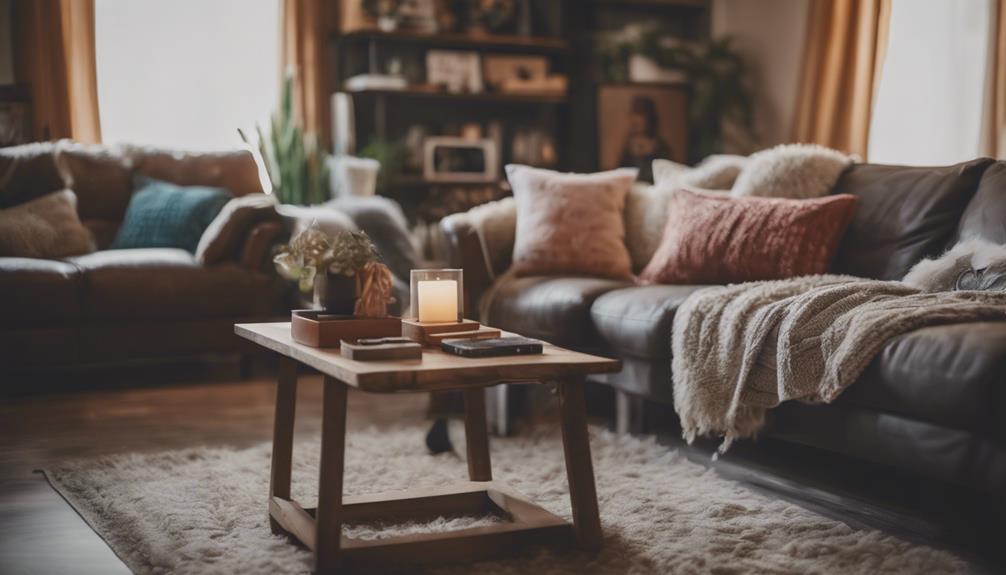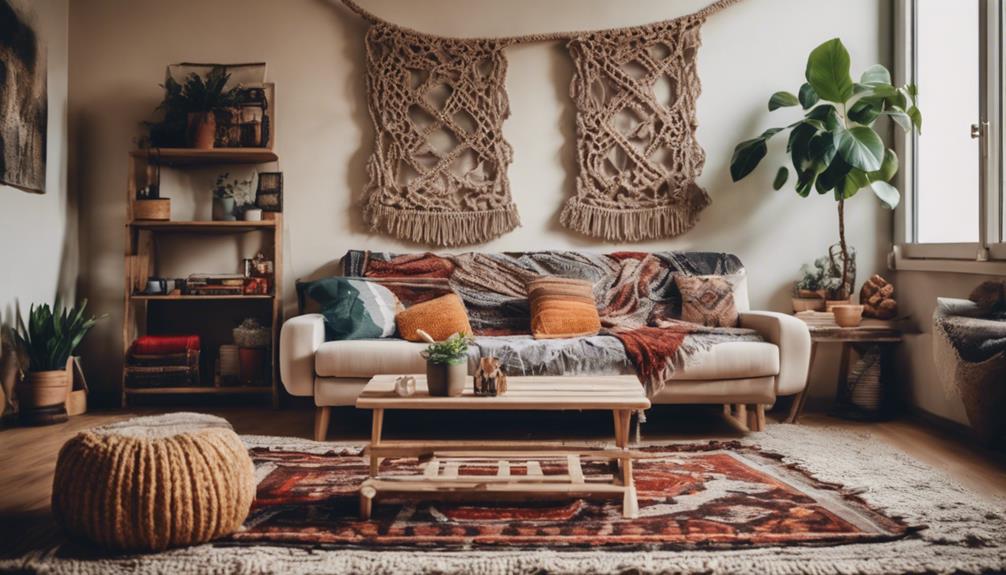Revamp your living space with DIY home decor, enabling you to customize your surroundings according to your preferences. From easy wall art to intricate furniture projects, DIY decor presents a cost-effective method to elevate your home’s aesthetics while showcasing your creativity. Handmade pieces bring a unique charm, instilling a sense of achievement and ownership. Cultivating a personalized atmosphere not only mirrors your uniqueness, but also nurtures an emotional bond with your space. Explore how DIY decor can exhibit your style, evoke a sense of comfort, and introduce warmth into your living environment. Discover the techniques for transforming your home with personalized accents.
Key Takeaways
- DIY home decor involves creating unique items for your living space.
- It allows you to add a personal touch and save money.
- DIY projects can include simple wall art and furniture renovations.
- Personalized decor showcases your style, creating emotional connections.
- Crafting handmade creations adds character and individuality to your home.
Understanding DIY Home Decor

When diving into the world of DIY home decor, you enter a journey of creativity and personalization for your living space. DIY projects offer a fantastic opportunity to add your unique touch to your home while saving money.
Decorating your home through DIY endeavors can range from crafting simple wall art pieces to taking on more complex furniture renovations. These projects not only enhance the aesthetics of your living space but also allow you to tailor the decor to your specific tastes and preferences.
Importance of Personalized Decor

When it comes to home decor, personalized touches are essential for creating a space that truly reflects your individuality.
By incorporating DIY projects into your decor, you have the opportunity to showcase your unique style and create a strong emotional connection with your living environment.
Personalized decor not only adds character to your home but also allows you to express your creativity in a way that's both fulfilling and budget-friendly.
Unique Expression Through Decor
Personalized decor in your living space adds a unique and inviting touch that reflects your individual style and personality. By engaging in DIY projects, you can create custom pieces that speak to your tastes and preferences. This personalized decor not only enhances the visual appeal of your home but also makes it more comfortable and welcoming.
Through decorating with personalized items, you have the opportunity to tailor your living environment to specific themes, color schemes, or design aesthetics. This hands-on approach to home improvement allows you to infuse your space with elements that resonate with you on a personal level, fostering a sense of ownership and pride in your home.
- Create custom pieces
- Tailor to specific themes
- Reflect personal tastes
- Foster a sense of ownership
Emotional Connection With Space
To truly connect with your living space on an emotional level, consider how personalized decor can infuse your home with a sense of individuality and warmth.
Decorating according to your individual tastes and preferences allows you to express your identity through design choices. Personalized decor items have the power to evoke feelings of comfort, nostalgia, and belonging within your home.
By incorporating these personal touches, you enhance the ambiance of your space, making it more inviting and unique. Repairing or customizing decor items to suit your style fosters a sense of ownership and pride in your living environment.
The importance of personalized decor lies in the emotional connection it creates, reflecting who you are and making your space truly yours.
Benefits of Handmade Creations

Crafting your own handmade decor items for your home brings a sense of personalization and creativity that enhances your living space uniquely. Engaging in DIY home decor projects allows you to express your individual style while reaping various benefits:
- Personalized Touch: Handmade creations add a unique touch to your living space, reflecting your personality and tastes.
- Cost-Effectiveness: DIY projects can be budget-friendly compared to store-bought items, offering customization without breaking the bank.
- Sense of Accomplishment: Crafting handmade decor pieces brings a feeling of satisfaction and achievement, contributing to a fulfilling DIY experience.
- One-of-a-Kind Pieces: Handmade home decor items are often one-of-a-kind, serving as conversation starters and showcasing your creativity and originality.
Expressing Creativity Through Decor

Express your creative flair through DIY home decor by designing and customizing unique pieces that reflect your style and personality. When you engage in DIY projects, you have the opportunity to express your creativity by crafting handmade items that are personalized to your taste. This process allows you to create decor that is not only cost-effective but also truly one-of-a-kind.
To help you get started on your DIY decor journey, here are some ideas for expressing creativity through handmade decor:
| DIY Project | Materials Needed | Benefits |
|---|---|---|
| Hand-painted Wall Art | Canvas, Paint, Brushes | Adds a personal touch to your space and allows for artistic expression. |
| Customized Furniture | Wood, Paint, Stencils | Tailors furniture to your style and creates unique pieces for your home. |
| Upcycled Accessories | Old Items, Decorative Materials | Repurposes items creatively, reducing waste and adding character to your decor. |
Creating personalized decor through DIY projects not only ignites your creativity but also adds a special touch to your living space.
Transforming Spaces With DIY

Revitalize your living spaces with DIY projects that bring new life into your home decor. Transforming your home with creative DIY projects can truly enhance the ambiance and add a personal touch to each room. Consider these ideas to inspire your next home decor project:
- Create Custom Wall Art: Use your artistic skills to craft unique pieces that reflect your style and personality.
- Refurbish Old Furniture: Give old furniture a new lease on life by sanding, painting, or upholstering them to match your decor theme.
- Design Custom Shelves: Build shelves that not only provide storage but also serve as decorative elements in your space.
- Paint Accent Walls: Choose bold colors or patterns to create focal points in rooms and enhance the overall aesthetic.
Engaging in these DIY projects allows you to express your creativity while transforming your living spaces into personalized sanctuaries. The satisfaction of completing these projects won't only save you money but also give you a sense of pride and accomplishment in your home design endeavors.
Creating a Unique Home Ambiance

Create a distinctive and personalized atmosphere in your home by incorporating DIY elements that reflect your individual style and preferences. By engaging in DIY home decor projects, you have the opportunity to create a unique ambiance that truly speaks to who you are.
These projects can range from simple crafts like handmade wall art to more complex tasks like refurbishing furniture to suit your taste. Not only does DIY home decor allow you to express your creativity, but it also presents a chance to save money while adding a personal touch to your living space.
Embracing these projects can be fulfilling and provide a creative outlet that enhances the aesthetics and overall atmosphere of your home. So, roll up your sleeves, gather your materials, and start transforming your living environment into a place that truly reflects your personality and style through DIY projects.
Frequently Asked Questions
Does DIY Mean Do-It-Yourself?
Yes, DIY means do-it-yourself. It signifies completing tasks independently without professional assistance. Engaging in DIY involves tackling home decor projects, repairs, and improvements without hiring experts.
What Does DIY Home Mean?
DIY home decor means creating personalized decorations without professional assistance. It involves crafting unique items like art, furniture refurbishments, or decor pieces tailored to your style.
Engaging in these projects lets you express creativity and save money while adding character to your living space. By making your own decor, you infuse your home with a personal touch that reflects your individuality and enhances the ambiance of your surroundings.
What Does DIY Mean in Slang?
In slang, DIY means 'Do It Yourself.' It signifies a hands-on, self-reliant approach to tasks, showing initiative and independence. DIY often conveys creativity, resourcefulness, a can-do attitude, and a willingness to tackle challenges.
Embrace the DIY spirit to take charge, be creative, and handle tasks on your own terms. Let your ingenuity shine through as you explore the world of DIY in various aspects of life.
Why Is It Called Diy?
When people mention DIY, they're talking about doing tasks on their own, without hiring professionals. The term DIY emphasizes independence and hands-on work.
It's called 'do it yourself' to highlight your active role in creating, fixing, or decorating things. By using DIY, you show your commitment to investing time, effort, and creativity in improving your home or crafting projects.
The DIY label underscores the idea of taking charge and actively participating in making or fixing things at home.
Conclusion
To sum up, DIY home decor enables you to express your creativity, customize your space, and cultivate a unique ambiance that mirrors your personality.
By integrating handmade creations into your home, you can revamp spaces and make them genuinely one-of-a-kind.
Embrace the potential of DIY to showcase yourself through decor and enhance the appearance and atmosphere of your living environment.
Let your imagination soar and relish the process of crafting a home that's truly your own.









